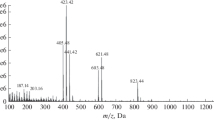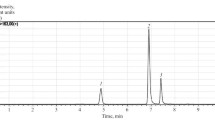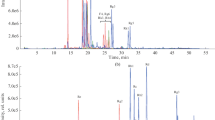Abstract
We performed identification tests of the main components (ginsenoside-Rg1, gentiopicroside, puerarin, geniposide, schizandrin, and [6]-gingerol) of the following crude drugs from the Japanese Pharmacopoeia, 14th edition (JP14): ginseng, red ginseng, gentian, Japanese gentian, pueraria root, gardenia fruit, schisandra fruit, and ginger). The identification was carried out with reversed-phase thin-layer chromatography using water, acetonitrile, methanol, 2-butanone, and n-hexane as developing solvents. A single spot could be separated from other components (Rf value: 0.44–0.59). In addition, spectral information could be simultaneously obtained by scanning densitometry. Thus, the main components of crude drugs in the JP14 could be identified by this method simply, rapidly, and accurately.



Similar content being viewed by others
References
The Society of Japanese Pharmacopoeia (1996) Jpn Pharmacop Forum 5:125–154
The Society of Japanese Pharmacopoeia (1997) Jpn Pharmacop Forum 6:31–32
The Ministry of Health, Labour and Welfare of Japan (2001) The Japanese pharmacopoeia, 14th edn, English version
Oka H, Ikai Y, Kawamura N, Yamada M, Inoue H, Ohno T, Inagaki K, Kuno A, Yamamoto N (1987) Simple method for the analysis of food dyes on reversed-phase thin-layer plates. J Chromatogr 411:437–444
Ohno T, Ito Y, Mikami E, Ikai Y, Oka H, Hayakawa J, Nakagawa T (1996) Identification of coal tar dyes in cosmetics and foods using reversed-phase TLC/scanning densitometry. Jpn J Toxicol Environ Health 42:53–59
Ueno E, Ohno T, Oshima H, Saito I, Ito Y, Oka H, Kagami T, Kijima H, Okazaki K. (1998) Identification of small amounts of coal tar dyes in foods by reversed-phase TLC/scanning densitometry with sample concentration techniques. J Food Hyg Soc Jpn 39:286–291
Ohno T, Mikami E, Matsumoto H. (2003) Identification of oil-soluble coal tar dyes in cosmetics using reversed-phase TLC/scanning densitometry. J Health Sci 49:401–404
Ozeki N, Oka H, Ikai Y, Ohno T, Hayakawa J, Hayashi T, Aoyama T, Kushibiki Y, Sato T, Ito M, Suzuki R. (1993) Applicability of reversed-phase TLC to the analysis of coal tar dyes in food. J Food Hyg Soc Jpn 34:542–545
Ohno T, Mikami E, Matsumoto H, Oka H, Nin I (2004) Analysis of crude drugs using reversed-phase TLC/scanning densitometry. (I) Identification of saiko, akamegasiwa and sanshuyu. Nat Med 58:218–221
Harada M (1989) Hanyou-shouyaku-no-seibun-teiryou. Hirokawa, Tokyo, pp 401
Author information
Authors and Affiliations
Corresponding author
Rights and permissions
About this article
Cite this article
Ohno, T., Mikami, E. & Oka, H. Analysis of crude drugs using reversed-phase TLC/scanning densitometry. (II) Identification of ginseng, red ginseng, gentian, Japanese gentian, pueraria root, gardenia fruit, schisandra fruit and ginger. J Nat Med 60, 141–145 (2006). https://doi.org/10.1007/s11418-005-0018-y
Received:
Accepted:
Published:
Issue Date:
DOI: https://doi.org/10.1007/s11418-005-0018-y




